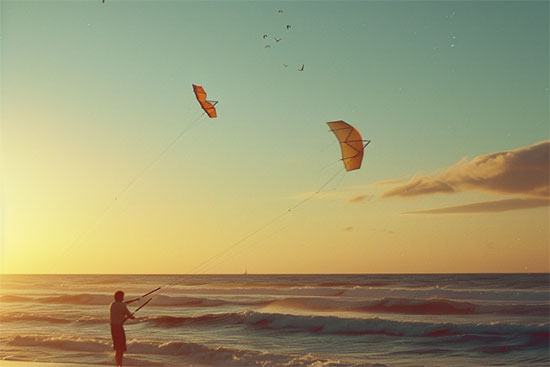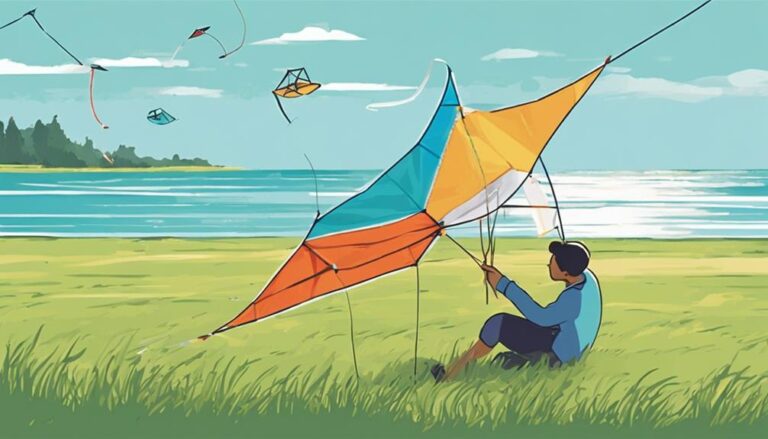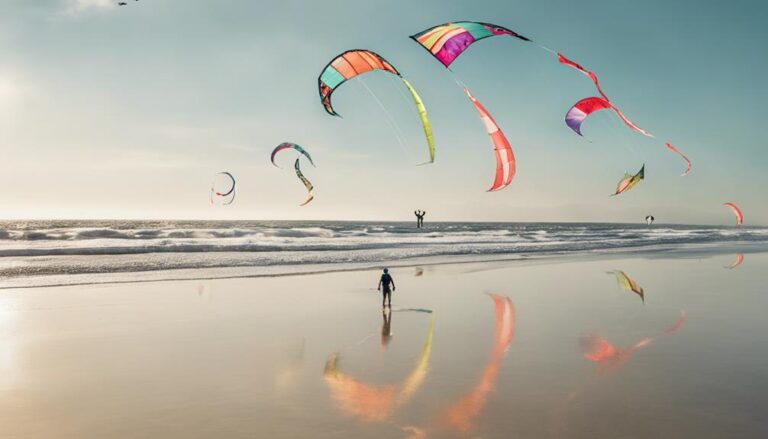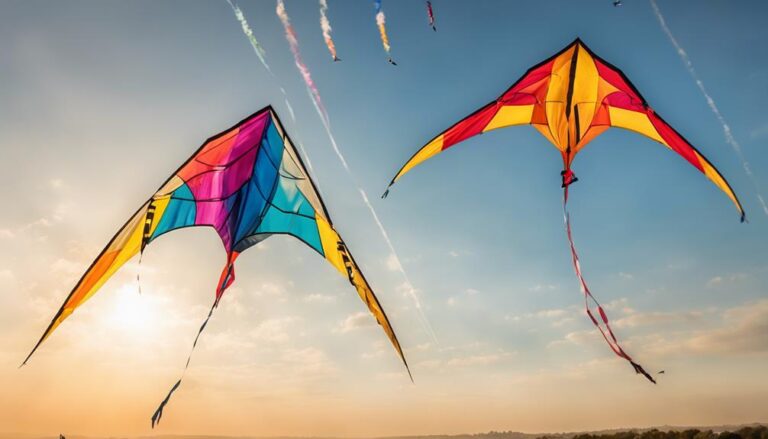Just as a sailor reads the sea before setting sail, you must consider multiple factors before choosing your kite for kiteboarding. The wind’s whispers dictate not just the size, but the shape and material of your kite, tailored to your weight, skill, and the dance you plan to perform on the waves.
But how do you navigate these waters, ensuring your choice enhances both performance and safety? Uncovering the right kite involves peeling back layers that go beyond the basic understanding of wind conditions. Let’s embark on this journey together, exploring the depths of what truly influences your decision.
Contents
Understanding Wind Conditions

To effectively choose the right kite, it’s essential to first grasp how varying wind conditions impact your selection, focusing on wind speed as the pivotal factor determining kite size.
When you’re preparing for a kiteboarding session, understanding the nuances of wind conditions is crucial. Monitoring wind forecasts informs you about the direction and speed, vital factors to consider for your kiteboarding kite choice.
Different winds necessitate different kite sizes; lower speeds require larger kites to generate sufficient power. Moreover, kite size choice is intricately linked to the wind range specific to each kite type.
Bow kites, for instance, offer a broader wind range due to their de-power capabilities, enhancing versatility across varying conditions. The wind window and power zones are also key determinants in selecting the appropriate kite size, ensuring optimal performance under diverse wind scenarios.
Kite Shapes and Functions

Understanding the impact of wind conditions on kiteboarding leads us to explore the significance of kite shapes and their functions, which play a crucial role in optimizing your performance on the water. Different kite shapes cater to specific riding styles and preferences, each designed to enhance your kiteboarding experience.
- C-KITE: Offers direct and precise steering, ideal for wakestyle riders seeking unmatched power and control.
- BOW KITE: Provides excellent depower and stability, suitable for riders looking for ease of use and versatility across various conditions.
- HYBRID/OPEN-C: Combines aspects of C-KITE and BOW KITE designs, offering a balance of performance and accessibility, making them a versatile choice for diverse riding styles, including freestyle, wave riding, and foiling.
Choosing the right kite shape is pivotal in maximizing your performance and enjoyment on the water.
Material and Construction
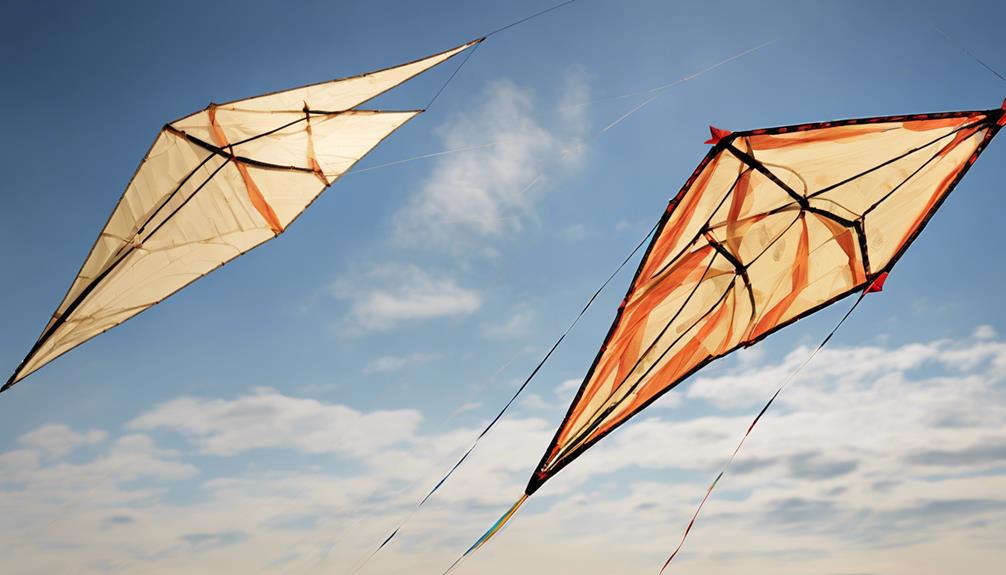
When selecting a kite, you must consider the balance between durability and the kite’s weight and flexibility, which hinges on the materials and construction techniques used.
High-quality materials like ripstop nylon and Dacron, coupled with meticulous canopy and bridle system design, ensure your kite withstands various wind conditions while maintaining performance.
The fusion of innovative construction methods with robust materials significantly extends your kite’s lifespan and enhances its aerodynamic properties for an optimal kiteboarding experience.
Durability Considerations
Selecting durable materials like ripstop nylon, polyester, and Dacron is crucial for a kite’s longevity and performance in various conditions. When you’re assessing a kite’s durability, consider these essential aspects:
- Material Choices: The foundation of durability starts with high-quality materials. Ripstop nylon offers exceptional tear resistance, polyester ensures longevity, and Dacron provides strength at critical points.
- Construction Techniques: Look for kites featuring reinforced stitching and leading-edge protection. Triple-stitched seams and high-tensile materials ward off wear and tear, enhancing the kite’s resilience.
- Care and Maintenance: Proper upkeep, including rinsing your kite with fresh water and avoiding prolonged UV exposure, significantly extends its lifespan. Opting for kites from reputable brands ensures access to detailed care instructions and guarantees quality construction.
Weight and Flexibility
Considering the weight and flexibility of a kite’s materials and construction is crucial for optimizing performance and maneuverability in kiteboarding.
The weight directly influences the kite’s responsiveness. Lightweight kites, crafted from advanced materials like ripstop nylon, offer you unparalleled control and the ability to execute quick, complex tricks with ease, making them a top choice for freestyle riders.
On the other hand, the flexibility aspect of material and construction plays a pivotal role in how the kite behaves in variable wind conditions. A kite that incorporates durable yet flexible materials can adapt better to sudden gusts, maintaining stability and ensuring a smoother ride.
Rider Skill Level
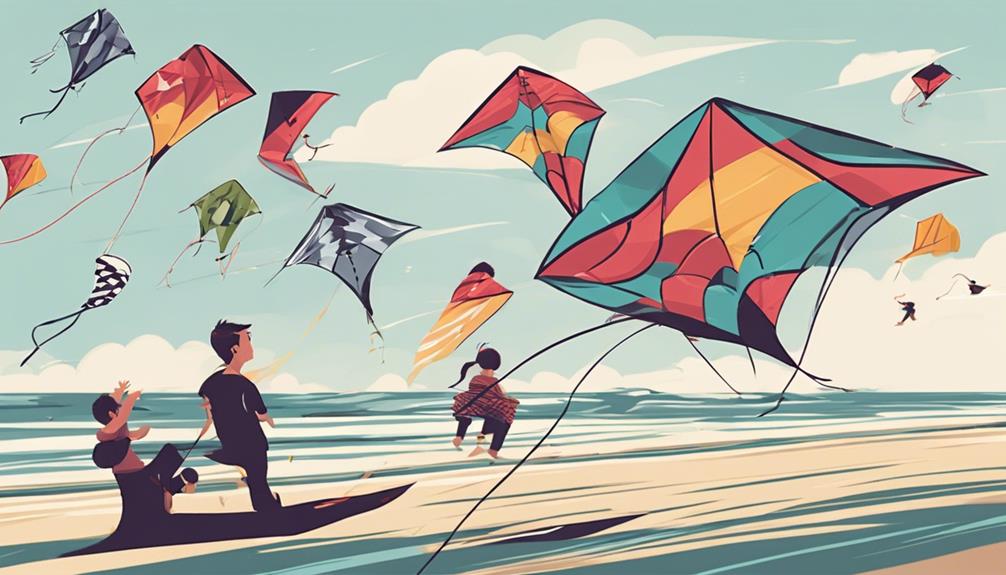
As you embark on your kiteboarding journey, mastering beginner techniques is crucial for establishing a solid foundation in kite control. Progressing to advanced maneuvers requires a nuanced understanding of your equipment’s capabilities, tailored to your evolving skill level.
Accelerating your skill progression speed hinges on selecting a kite that aligns with your current proficiency, ensuring a safer and more enjoyable experience.
Beginner Techniques Mastery
Mastering basic techniques like body dragging, water relaunching, and board control is the first crucial step for beginner kiteboarders embarking on their journey. As you dive into beginner techniques mastery, it’s imperative to understand how various factors influence your learning curve and kite choice.
- Wind Speeds: Lighter winds might require larger kites with more surface area to catch enough wind, while stronger winds necessitate smaller kites for manageable control.
- Rider Weight: Heavier riders may benefit from kites with greater surface area for sufficient lift, whereas lighter individuals can operate with smaller kites.
- Surface Area: A kite’s surface area directly affects its lift and maneuverability; beginners often start with kites that offer a balance between ease of use and performance to facilitate learning basic skills.
Advanced Maneuvers Learning
For advanced riders aiming to elevate their skills, selecting a smaller, more agile kite becomes essential for executing complex maneuvers with precision.
A small kite, with its inherent fast turning speeds, allows you to dive deeper into the realm of advanced tricks, where every nuance of kite control is critical. The tight, rapid loops necessary for high-level maneuvers demand a kite that responds instantly to your commands. This responsiveness is pivotal for mastering intricate aerial tricks, where precision is non-negotiable.
Furthermore, advanced riders gravitate towards kites boasting a superior power-to-weight ratio, enabling more dynamic, forceful maneuvers. Such kites amplify your ability to manipulate wind power, transforming it into spectacular aerial displays that push the boundaries of kiteboarding.
Skill Progression Speed
Understanding your rate of skill progression is crucial in selecting a kite that optimally aligns with your current abilities and future ambitions in kiteboarding. As you evolve as a rider, your kite size should adapt to ensure optimal performance, safety, and control.
Here are key considerations:
- Beginners benefit from smaller kites, facilitating easier skill development and greater control.
- Intermediate riders might transition to larger kites, aligning with their advancing skills for improved performance.
- Advanced riders often select specific kite sizes that match their refined techniques and unique riding style, maximizing efficiency and enjoyment.
Recognizing your skill progression speed enables you to tailor your kite size selection, enhancing your journey through the kiteboarding ranks from novice to pro, ensuring safety and enjoyment at every stage.
Kite Size Considerations

Selecting the right kite size is crucial, as wind speed significantly influences your choice, requiring you to assess specific square meter kites for varying conditions.
Considering rider weight is key; heavier riders need larger kites for optimal performance. Beginners should opt for sizes that are easier to control, enhancing safety during the learning curve.
Your riding style, whether it’s freeride, freestyle, wave riding, or foiling, dictates your kite size preference to boost specific techniques.
Safety considerations can’t be overstated; the correct kite size is vital for a positive and secure kiteboarding experience.
Location and Environment

While considering kite size and its relation to wind speed and rider weight is crucial, it’s equally important to factor in the specific location and environmental conditions where you’ll be kiteboarding.
The choice of kites is highly influenced by:
- Location: Coastal areas with consistent sea breezes differ vastly from the variable winds of inland locales or the tricky wind shadows urban environments generate.
- Wind Conditions and Local Weather Patterns: Understanding these can guide you in selecting a kite size that adapts to the prevalent conditions, ensuring optimal performance.
- Environmental Factors: Obstacles, like buildings, and natural phenomena, such as thermals, can significantly alter wind behavior, necessitating a kite that can handle these variable conditions.
Selecting the right kite involves a detailed analysis of these aspects to match your gear with the environment perfectly.
Conclusion
In conclusion, tailoring your kite choice to match wind conditions, kite shape, and construction is crucial for optimizing performance. Consider your skill level and the specific demands of your riding style.
The right kite size, influenced by your weight and the local environment, ensures safety and maximizes enjoyment.
By diving into the technical details and embracing innovative designs, you’ll find a kite that elevates your kiteboarding experience, blending precision with the thrill of the sport.

